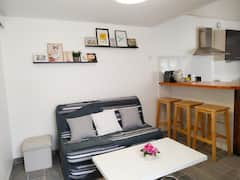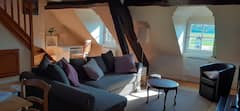Chateau de Chantilly, located at the outskirts of the homonymous town to the north of Paris, used to be the home to a couple of illustrious personalities who left a significant mark on the chateau and France. Aside from interesting historical background, Chateau de Chantilly offers to its visitors chance to enjoy outstanding architecture, interior decoration, the second largest collection of paintings in France (only behind Louvre) and a stroll through a few differently landscaped gardens.
Historical facts of the Chateau de Chantilly

Although the beginnings of the Chateau de Chantilly date back to the 14th century, its history is mostly related to Anne de Montmorency (the 16th century), Louis de Bourbon, better known as the Great Conde (the 17th century) and Henri Eugene Philippe Louis d’Orleans, the Duke of Aumale (the 19th century). Anne had the chateau commissioned, while the Great Conde altered the initial design of its gardens, entrusting the work to famous Andre Le Notre, Louis XIV’s chief gardener. The Duke of Aumale contributed with an impressive collection of paintings, books and other works of art, and had the Grand Chateau erected, using the foundation of the 14th century fortress, destroyed during the French Revolution (1789 – 1799).
Being left without heirs, who died prematurely, the Duke of Aumale bequeathed the estate to the Institute of France in 1886; the Conde Museum was open to the public in 1898, never alternating its original 19th century appearance. Within its premises, you’ll discover marvellous design, interesting destinies of its former residents and engaging works of art.
Chateau de Chantilly’s architecture

The chateau, located on the ground encircled by a lake, is a mixture of various interesting styles, somewhat similar to those of castles Ecouen, Fontainebleau and several others. The Petit Chateau, commissioned by the High Constable Anne the Montmorency, features the Renaissance style. Neo-Renaissance style, applied on the Grand Chateau, was the style in vogue during the reign of Louis-Philippe (1830 – 1848), the Duke of Aumale’s father.
The external features of the chateau diverge as far as following the same constructional fundamentals allows. The facades of the both edifices feature large and densely distributed windows, true, but the triangular Grand Chateau dominates the surroundings with its cupolas, spires and oval turrets. Niches distributed around the edifice are filled with various works of art (amphorae, for example), while the Petit Chateau is decorated with the Corinthian columns and various busts. Despite their differences, both wings are harmoniously fitted, exuding the utmost elegance.
Exquisite style of the Chateau

The main staircase is located at the intersection from where the chapel, the Petit Chateau and the Grand Chateau are accessed. Dark tones of its iron wrought rail, sculptural details and background decoration make an interesting contrast to the stonework and natural illumination.
While proceeding into the Chateau, you’ll be introduced to its opulent, yet stylish, decoration, featuring intricate carvings, various stories recounted by small details through tapestries, wall paintings and such, period furnishing, stucco works, busts, and other.
Throughout the chateau, you’ll pass through numerous chambers that exhibit various works of art originated through different periods. Don’t miss the Battle Gallery (depicting the military career of the Great Conde), the Library of the Duke of Aumale, the Psyche Gallery, the Art Gallery and the Santuario.
Behind the altar of the Chapel, look out for exquisite artwork related to Greek mythology and religion, and the urn containing the hearts of the Condes.
You might be interested in these Airbnbs!
The Chateau de Chantilly’s works of art

The works of art cover a wide area, from honouring the beauty of the women and recounting popular mythological scenes and stories to portraits of high aristocracy and royalty, and illustrations of military lives of the Chateau de Chantilly’s residents (the Great Conde and the Duke of Aumale).
One such painting, in the Battle Gallery, depicts the colossal victory of the Great Conde’s army over the Spaniards, at Rocroi, in 1643. This painting makes a dramatic contrast with the one illustrating the Great Conde’s atonement (refer to the first photo in the article).
Not long after the Great Conde won one of the greatest victories for the French crown in history, he turned against the young King Louis XIV (the Sun King), and led the Second Fronde uprising. He made a pact with the Spanish King, and was aided in his quest by the Spanish forces. However, the Second Fronde was crushed, and the Great Conde was sentenced to death. Fortunately, he was pardoned, and faithfully served the French crown until his retirement. The related painting depicts the Great Conde in the company of the muses. The strongest allegory is related to the muse of history, who tears apart the pages inscribed with his actions against Louis XIV.
The Duke of Aumale had a rich military history, too. The painting above depicts an episode of his engagement in the northern Africa (probably Tunisia), while making a bargain with his opponent. However, since his father, Louis-Philippe, was overthrown very soon, he never managed to meet his part of the deal. Such an inability tortured him till the rest of his days, and the sheikh never forgave him.
Perhaps most outstanding stained glass windows you’ll ever see are located in the Psyche Gallery. Created for Anne the Montmorency, the series of windows depict popular legend about Cupid and Psyche, the mortal more beautiful than Aphrodite, the goddess of love. One cannot help but to wonder that the work must have impressed the revolutionists since they left it undamaged.
Other highlights include Simonetta Vespucci, by Piero di Cosimo, The Massacre of the Innocents, by Nicolas Poussin and The Three Graces, by Raphael. Various interesting items that belonged to various historical personalities are located in the Gem Cabinet.
Gardens of the Chateau de Chantilly

The Chantilly estate boasts three exceptional gardens and a park.
The English Garden features winding paths, riding trails, rich vegetation and a few exceptional facilities devoted to mythology, love and beauty. Aside from the Venus Temple (the photo above), you’ll come across the Love Island, the Bridge of Illustrious people and the Beauvais Fountains, designed by Andre Le Notre.
The French Formal Garden, inaugurated by Andre Le Notre himself, features various geometric shapes of bodies of water and vegetation. Edged by lawns and sculptures, they are composed into a perfect unity. The Grand Channel, fountains and grottos contribute to the almost unearthly beauty of Andre Le Notre’s creations.
The Anglo-Chinese Garden, “squeezed” between the French Formal Garden and Hamlet, combines the Oriental gardening style with various plant species. Hamlet, a reconstruction of the old settlement, features a water mill, cute gardens, wooden establishments and a restaurant. Nearby labyrinth is an excellent spot to practice your resourcefulness.
By wandering through the Park, you are likely to stumble upon a kangaroo enclosure, endlessly charming Sylvie Mansion, water cascade and various interesting sculptures; aside from the huge amphorae, open your eyes for the “wild boars’ monument”.
The Chantilly is a migrating stop for various bird species; if you happen to be here during the migration, you’ll be able to observe the rich wildlife of these regions.
The Great Stables

Established by the Great Conde next to the chateau, the Great Stables offer to the castle’s visitors free dressage demonstrations and exhibitions covering themes like horse breeds, evolution of the horse, the role of the horse in the human life, wars, hunting, etc. By visiting the boxes, you’ll be surprised by the horses’ names, such as Ramses the Great, which is a name of a Shetland pony.
During the dressage demonstration, you’ll see how the horse curtsies, passage of the Shetland pony beneath the belly of a great stallion, etc. If possible, bring with you a person knowledgeable in French because narration is provided only in this language.
Prepare your visit
To reach the Chateau de Chantilly (40 km from the centre of Paris) by car, you should take the A1 or A3 motorway, getting out at the Chantilly exit.
The second best option is to jump into the SNCF train line at Gare du Nord, alighting at the Chantilly-Gouvieux station. The station is located outside the Parisian public transport zone – you need to purchase a full price ticket. The shuttle bus to the chateau is available at the Chantilly-Gouvieux station, but you can easily reach it in twenty minutes by walk. Along the way, you can visit the interesting Notre Dame church.
Operating hours are from 10:00 to 18:00 during the high season (April - November), while neighbouring grounds close at 20:00. Holders of the Paris Museum Pass, and other similar passes, have free entrance to permanent exhibitions. Guided tours, only in French, are available for the Private Apartments of the Aumales, the chateau’s architecture, Andre Le Notre’s water works, etc. Free audio guides are available in several languages.
In order to fully explore the Chateau’s premises and gardens, you should plan at least 6 hours. Each additional hour would be a big plus. Given that the chateau tends to be more crowded during weekends, it would be excellent to organize your visit during working days.
History
Get Trip101 in your inbox
Unsubscribe in one click. See our Privacy Policy for more information on how we use your data




















Create an account to